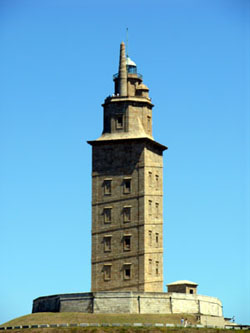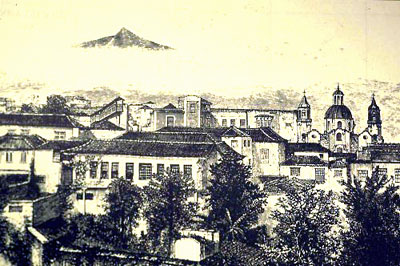|

Torre de Hércules, La Coruña,
Galicia.
(Murray, 2006) |
Relations
between Ireland
and the Iberian Peninsula
have their roots deep in the mists of myth and history.
According to the Irish Leabhar Gabhála (book of
invasions), the last wave of settlers to arrive in Ireland
came from the Iberian Peninsula. During the middle ages, trade and fishing created strong
links between Ireland
and the Peninsula. Foreign fishing vessels working in the fishing grounds of
Grand Sol docked in Spanish ports for some months every year.
For example, in 1571 around eighteen chalupas
(fishing boats) from Gijón, Ribadesella and
Llanos worked in Irish fishing grounds (Gomez-Centurión
1988).
During
the sixteenth century, Irish-Iberian connections took on a
religious and political dimension. The first diplomatic
contacts and treaties between the Irish nobility and the
empire of Charles V date back to 1529. Iberian political
involvement in Ireland increased progressively from the 1520s to the 1640s. The myth
of the Iberian origin of the inhabitants of Ireland (the
‘Milesian myth’), a sense of solidarity based on
Catholicism and the services rendered by the Irish in the
armies of Spain, together with a strong campaign of cultural
reinvention and projection carried on by the Irish with the
Spanish Monarchy, convinced the kings of their duty to protect
and defend the Irish.
Parallel
to the profound transformation that the English state wrought
in Ireland
in the sixteenth and seventeenth centuries, a strong Irish
community flourished in the territories of the Spanish
Monarchy, mainly Castile, Portugal and the so-called Spanish Netherlands. On the other hand, as
Declan Downey has demonstrated, the nature of the Irish
Counter-Reformation movement was much more related to the
Castilian monarchist model than to that to the Roman one
(Downey 1994).
These
sixteenth and seventeenth century migrations are best
remembered in relation to the military commanders that served
in the Spanish Army of Flanders (some of whom returned to Ireland
in the 1640s) and the almost thirty Irish colleges scattered
around Europe. Less known is the political role played by a small Irish
lobby at the courts of
Lisbon, Madrid
and Brussels, in defence of the rights of the dispossessed nobility and
Catholic Church.
On
the other hand, the experience of the tens of thousands of
migrants who served in the army as foot soldiers, and their
dependent families, studied here by Moises Enrique Rodríguez,
was full of hardship and need, as happened with many that took
the mestiere delle arme.
Many of them ended up dissolving in the marginal groups of
society, as can be seen in the number of Irish making their
last will at the paupers’ hospitals of Madrid, or in the satiric works of Francisco de Quevedo. De Quevedo
tellingly used the word irlandesa
interchangeably with prostitute. However, there were also
merchant settlers who opened up Iberian and American commerce
to European networks of trade and acted as backdrop to the
Irish commercial success of the eighteenth century.
|

'Sir, these are all Catholics and very good
people,
but they are only Christians of St. Patricio'
(The History of the Discovery and Conquest of the
Canary Islands,
by Abreu de
Galindo, translated by George Glas, 1764,
p. 205)
|
Although
the Spanish political role in Ireland
was overshadowed by France’s influence and the stronger English and Scottish authority
on the island from the 1650s onwards, the eighteenth century
might be considered the golden age of the Irish presence on
the Iberian Peninsula. Starting with Daniel O’Daly (1592-1662) as one of the
diplomatic cornerstones of the Portuguese Crown during its war
of independence from Spain (1640-1668) until the era of
Leopoldo O’Donnell (1809-1867), military commander,
political leader and prime minister, both Portugal and Spain
boasted high-ranking diplomats, military men and politicians
of Irish origin at their service.
On
the other hand, Irish merchants benefited from the full rights
of Spanish citizenship, confirmed by the new Bourbon dynasty
in 1701, in order to boost their trade. The most famous son of
this trading aristocracy was the writer, poet and theologian
José Blanco White (1775-1841) who in his writings refers to Lower Andalusia, the hub of Spanish intercontinental trade where he grew up.
On this issue, Manuel Fernández Chaves and Mercedes Gamero
present the unknown business and social context of the Irish
community in eighteenth-century Seville.
Recent
works to be published by the end of this year by Oscar Recio
Molina and Enrique García Hernán show the success of Irish
girls of marrying age at the Spanish Court among military officers, thanks to their social and cultural
capital. On the other hand, Oscar Recio himself argues that in
the same eighteenth century, some financial capital was always
welcomed in order to have Irish claims to nobility swiftly
recognised by Iberian administrations. However, high statesmen
and military commanders such as Richard Wall (1694-1777),
studied here by Diego Tellez Alarcia, and Alexander O’Reilly
(1722-1794), endured severe criticism on the grounds of their
being considered foreigners. |



